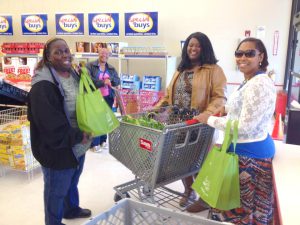Do you consider buying groceries a real grind? A necessary evil? Well, it may never turn into a fun adventure for you, but there are some things you can do to make it easier on you and your budget.
Grocery shopping actually begins at home:
 Keep a note pad handy in the kitchen to make a list; when staple items are getting low, add them to your list so you won’t forget to replenish them. Then let your fingers do the walking through the grocery store ads to see which stores have the best buys on what you need.
Keep a note pad handy in the kitchen to make a list; when staple items are getting low, add them to your list so you won’t forget to replenish them. Then let your fingers do the walking through the grocery store ads to see which stores have the best buys on what you need.- You may want to plan menus around advertised specials and seasonal foods. It helps to have menus planned for the week so you can be sure to have all the necessary ingredients on hand.
- If you plan to use paper coupons, clip them to the list or use an electronic app. It is helpful to have the list organized according to the layout of the store to avoid backtracking for missed items.
- When shopping, buy non-perishables first and save refrigerated and frozen items for last. Make the grocery store your last stop if you are doing other errands. Once home, frozen and refrigerated items should be brought in and stored first.
- Finding the best buy can sometimes be a little tricky. Doing your homework with grocery ads is a good start for comparison shopping. When you get to the store, a little more detective work may be needed. If the store has it, learn to use unit pricing. This is the label on the shelf which gives not only the total price but also the price per unit (ounces, pounds, sheet, etc.). Buying larger sizes often saves money. However, this is not always the case, so use unit pricing or a calculator to check (divide the price by the number of ounces, pounds, etc.). Even if the larger size is cheaper per unit, be sure you can use all of it; if it spoils or can’t be stored, it is not a bargain. Can you divide foods into smaller portions and freeze some for later, or share with a friend?
- Another way to save is to compare national brands with store brands which are usually cheaper. The quality may or may not be the same, so try it once to see if it is acceptable. The nutritional value is usually the same.
- Buy the quality or form you need for the purpose. For example, don’t buy whole canned mushrooms then chop them into pieces if buying a container of already cut mushroom pieces is cheaper.
- Compare fresh, frozen and canned forms, especially for seasonal produce.
- Shop on a full stomach and alone if possible. Hunger and children often lead to impulse buying.
- Buy only the items on your list; anything else should be avoided unless it is a good buy on something you’re sure you will use.
- A larger portion of our “grocery” bill is actually for non-food items such as household cleaners, paper goods, personal grooming products, etc. Comparison shopping is important here too. Are there other types of stores where these products might be cheaper? Can these be purchased cheaper in bulk?
- Convenience foods are a part of today’s lifestyle. While they may save us time, they are usually more expensive than the homemade version. With some convenience foods you are paying for labor; grated cheese, cut up chicken, etc. With others we are paying for having ingredients packaged together; meat helpers, macaroni and cheese or vegetable sauces, etc. Compare time savings with the added cost. Are you paying for ingredients you may already have on the shelf or are easily purchased separately?
If you have questions about budgeting, shopping, menu planning or nutrition, contact your Family and Consumer Science Extension Agent.
For further information contact:
Dorothy C. Lee, C.F.C.S.
UF/IFAS Extension Escambia County
dclee@ufl.edu
 0
0

